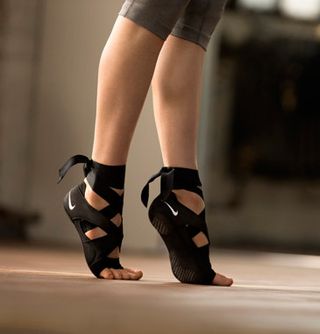What to Know Before Taking Your First Barre Class


For those of us with a full hand on the pulse of all things health and wellness, barre isn't a new concept: The trendy ballet-derived fitness class is adored by models like Gigi Hadid, Karlie Kloss, and Alessandra Ambrosio (you know, of the Victoria's Secret genus). Leg warmers, barre shoes, and lithe limbs outstretched over wooden barres have filled up our Instagram feeds for years, and yet, presumably for those geographically distant from fitness-centric destinations like New York and L.A., barre is still a bit of a foreign concept: Google tells us that users search "What is barre?" almost 2K times per month.
Allow us to demystify this question for anyone still curious about the celeb-loved workout—and to do so, we went straight to the source: Leila Fazel, the co-founder of Aerospace High Performance Center and a barre expert. Below, learn all about the leg-lengthening workout.

First thing's first, in layman's terms, barre is the combination of pilates, yoga, and ballet wherein you balance yourself (typically on a barre, of course) while you contract your body in small movements for several repetitions. A month of unlimited classes will usually run you around $100, but you don't have to physically go to a barre studio to reap the benefits: Says Fazel, "All these maneuvers can be executed by either holding onto something for balance or with the arms held out to the side and slightly in front of the body."
It's all about positioning, though (as ballet often is) so she urges you to pay attention to your movements and stance: "If the arms fall behind the body, it makes it more difficult to keep balance," warns Fazel. "The alignment of the body requires a continuous force pushing down through the heels and up through the crown of the head. The core should always be engaged, creating stability, and the shoulders pressed down. All the maneuvers should begin in a standing position with heels together and feet turned out at a 45-degree angle. The rotation should come from the upper thighs and hips and not forced from the knees or ankles."
What to Know Before Your First Class
"Some of the movements may seem small and subtle, but if done properly, can still be very effective for toning and shaping," says Fazel. In other words, if you're used to big sweeping cardio movements, you're going to need to keep your range of motion smaller (think one-inch movements) in barre. Also, be prepared to feel the burn. Andrew Ash, a master trainer at Barre3, previously told us that painless deep muscle burn may occur in areas prone to injury. This will help strengthen these areas to help cut down on future muscle strain.
Additionally, you may not know what's going on in your first class: You'll learn a lot of new ballet jargon like plié and fondu, but you'll pick the terms up quickly after several repeated movements. (If you want a head start, check out Gigi's favorite exercises from Mary Helen Bowers of Ballet Beautiful.) But know that the instructor(s) are there to help you, so don't worry about being lost.
The core of the class is the way in which you hold your hips. As mentioned earlier, the abdominal muscles should always be engaged during barre. This is known as a tuck, where your pelvis tilts upward and your lower back tucks under. This way, you're not arching your back and placing weight on the spinal discs. Practice the tuck before your first class to avoid unnecessary back pain and to get the hang of the foundational barre position.
So what is a typical class like? First, you begin with floor work, such as planks, pushups, and free weights (generally very light, around five pounds each arm) to strengthen and warm up the upper body. Next, comes the barre work, where the focus is on the legs and the glutes. You'll then finish off with a cooldown—a series of stretches to help the muscles recover. The class is around an hour total.

What to Wear
"Always wear clothes that are comfortable to move in," says Fazel. Generally, form-fitting leggings and tops are best so your instructor can accurately examine your form (and so you can check it out in the mirror, too).
"Footwear really depends on the class," she says. "Check in prior to arrival to see which appropriate footwear is required for the particular barre class, as it varies." Some classes allow you to go barefoot, while others may recommend special gripped socks to avoid slipping.
What to expect afterward
Barre is a great way to tone and sculpt muscles. Says Fazel, "Ballet barre will work muscles in a way that yoga or a dance class won't pinpoint." It will also help you build a covetable ballet physique by helping you become more flexible and improving your posture. But these are just some of the benefits—take a look at the many other reasons to point your toes and plié.
Interested in barre but not ready to invest in a class? Try Lindsay Ellingson's at-home version.
Disclaimer
This article is provided for informational purposes only and is not intended to be used in the place of advice of your physician or other medical professionals. You should always consult with your doctor or healthcare provider first with any health-related questions.


